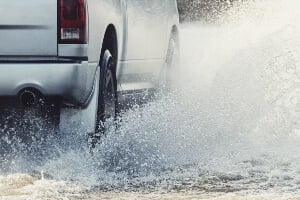Heavy Rain Crashes – What is the Risk and Who Can Be Liable?
Posted on behalf of Jeff Pitman on July 25, 2023
in Car Accidents
Updated on April 24, 2024
 Bad weather does not get a driver off the hook for negligence, even if severe conditions, like heavy rain, cause a crash.
Bad weather does not get a driver off the hook for negligence, even if severe conditions, like heavy rain, cause a crash.
Determining fault is rarely straightforward, but bad weather always increases the risk of a traffic accident. Additionally, drivers who get behind the wheel despite extreme rainy weather still have a legal duty to others sharing the road.
PKSD discusses driving during thunderstorms and other wet weather conditions in Milwaukee, including how liability applies if these conditions lead to a crash.
Injured in a heavy rain crash and not sure if you have a case? Call our law offices today or at any time, day or night, to learn if you have legal options. Our experienced Milwaukee auto accident lawyers are here to help.
Request your FREE case review today. 414-333-3333
What Are the Dangers of Driving in Heavy Rain?
Heavy rain downpours increase the risk of a crash, even when drivers are careful. However, there are additional dangers of driving during extreme wet weather conditions due to:
Low Visibility
Low visibility is a big problem during a heavy downpour. The rain alone can make it difficult to see other vehicles around you. However, sometimes other conditions exist at the same time, such as fog, high winds or low light. Often, it can be difficult to tell if you are approaching a pool of water. It may also be harder to see other vehicles around you. If larger SUVs or trucks pass you, they may throw a sudden gush of water onto your windshield, further limiting your ability to see.
Risk of Hydroplaning
When it is pouring rain, drivers may stick to the right lane. However, this is an area where rainwater may pool. Even at 35 miles per hour, bigger pools of water can be difficult to drive through without hydroplaning.
Inexperienced Drivers
Driving through a first heavy downpour could be extremely nerve-racking. Inexperienced drivers, especially teens who have not had their licenses long, may not know how to navigate during these conditions.
Overly-Cautious Drivers
Overly-cautious drivers are a nightmare to share the road with, even when the weather is dry. However, during summer thunderstorms and other wet weather conditions, nervous drivers can increase the risk of a crash. Timid drivers often send out confusing signals because they are unsure how to handle any situation they consider dangerous, such as merging lanes. These fears only increase when weather conditions are severe.
Slippery Road Conditions
Vehicles are always dropping oil and other greasy substances onto the roads. Over time, these spills accumulate on the asphalt and other driving surfaces. When it rains, these oily spills rise to the surface, mixing with the water and making the roads dangerously slippery.
When roads are slick from rain, your tires will have a harder time maintaining traction. It takes longer for your vehicle to stop – which is why you need to allow more time and distance to stop
Why Should Drivers Be Liable for Crashes Due to Heavy Rains?
No matter what the weather conditions are, drivers owe a legal duty to other drivers and passengers. Keeping that in mind, if drivers go out during extreme wet weather, they have a legal duty to prevent harm to others. This duty means taking certain reasonable steps, such as:
- Putting on your headlights: This one simple step makes it easier for other vehicles to see you.
- Slowing down: Reduce your speed, putting more space between your vehicle and others.
- Avoid slamming on your brakes: Hard braking could cause you to hydroplane or spin out of control.
- Increase your following distance: Another small, but important step. This can help you to avoid a crash in heavy rains by giving you more time to stop. Cars cannot stop as quickly in wet weather.
- Signal properly: Using your turn signals during bad weather conditions is especially critical. It helps to alert other drivers around you when you merge, change lanes or turn.
- Maintain your vehicle: Ensuring everything, such as brakes, head and taillights, are working properly plays a huge role in vehicle safety. Your tires are equally important, so be sure they are properly inflated and not worn.
Sometimes, the best decision is to not go out during a heavy downpour or to find a safe place to pull over and wait out the worst of the rain. Remember also when driving through residential areas and on busy city streets that some pedestrians and cyclists may be trying to navigate the weather as well.
How is Liability Determined for a Crash Due to Heavy Rain?
Crash scene investigators will examine the scene of the crash, including vehicle damage, to determine what caused it. They will also speak to all of the drivers involved, as well as any witnesses who may have seen what happened. Other evidence could include crash scene photos and surveillance footage, if available.
If the driver causes a crash due to negligence, such as failing to take additional safety precautions due to the weather, he or she can be held liable.
Call Our Law Offices for Legal Help After a Crash in Heavy Rain
At PKSD, we have been helping victims of negligence for decades. If another driver’s negligence led to your crash and subsequent injuries, we are here to help. You may be eligible to recover significant compensation for your medical costs, lost wages and other losses.
Get started with a free case review. If we represent you, there is nothing to pay us up front. We only get paid for our services if we are successful in winning compensation for you.
Millions recovered for our clients. 414-333-3333






